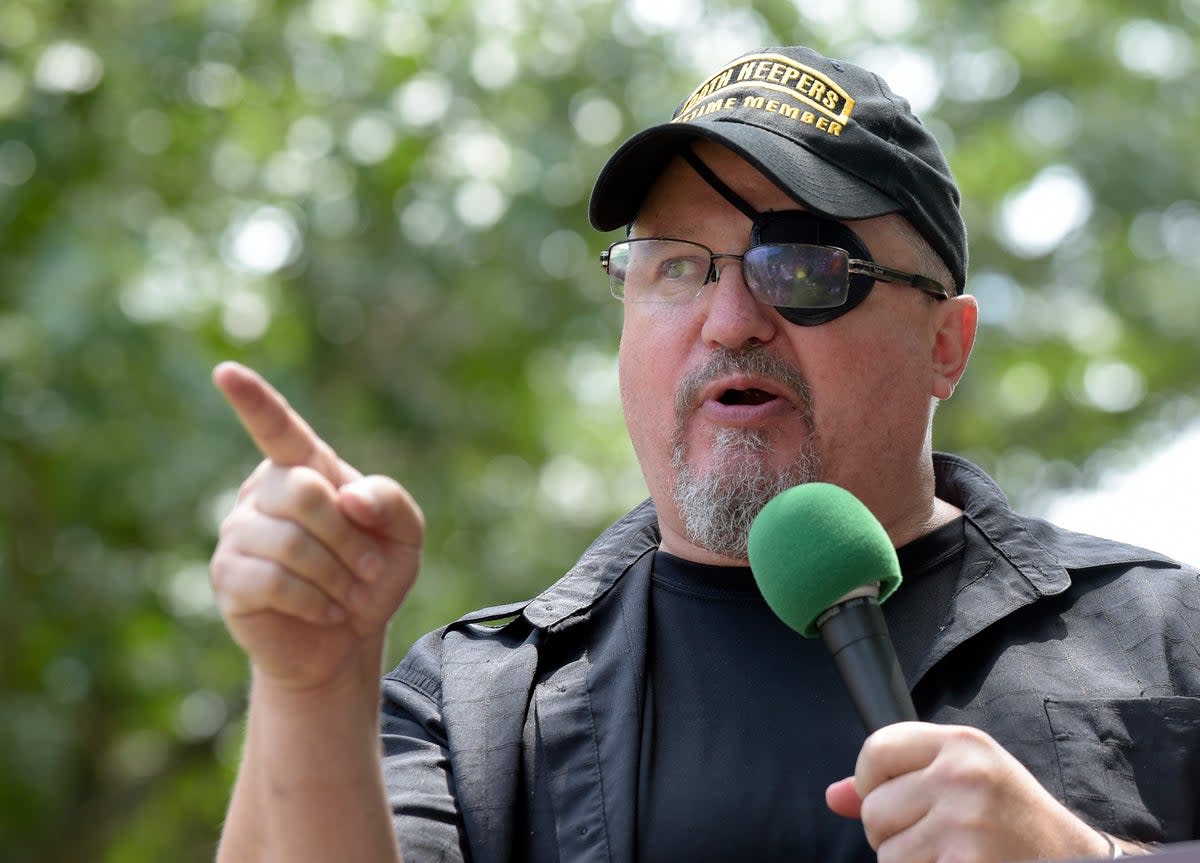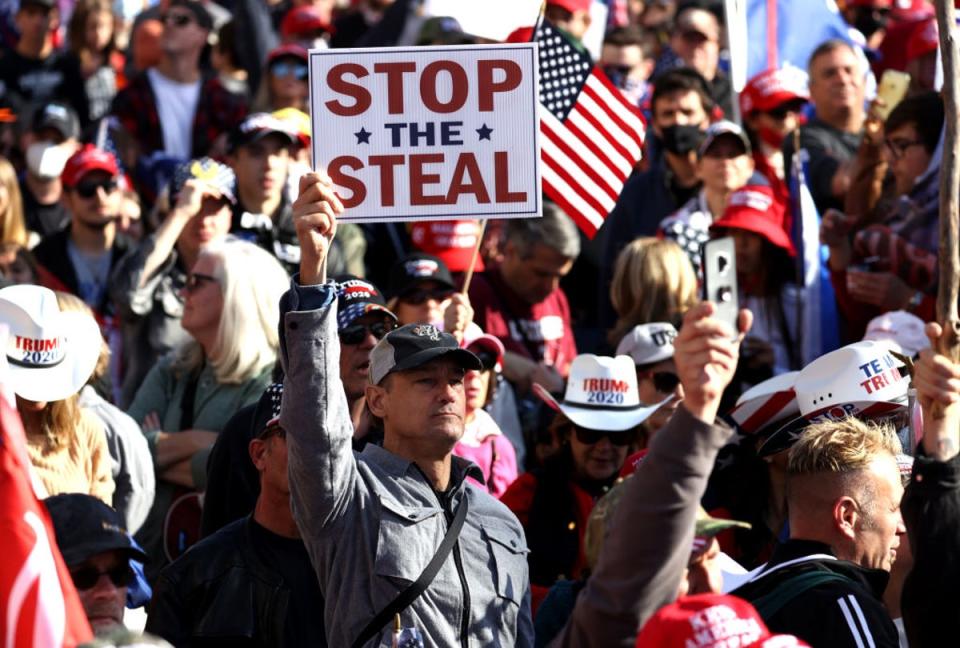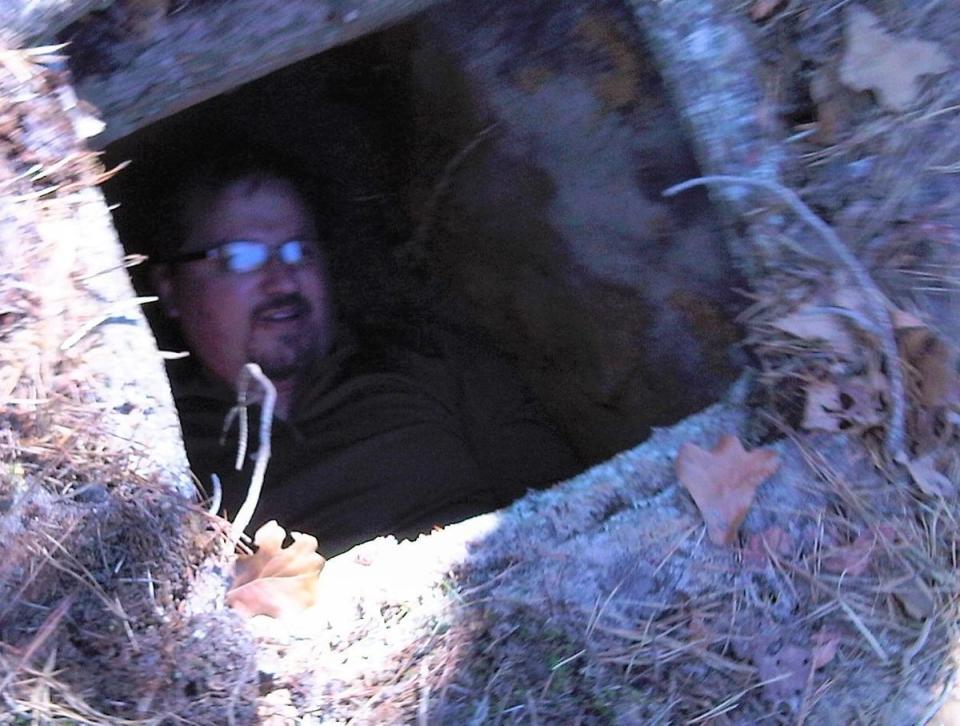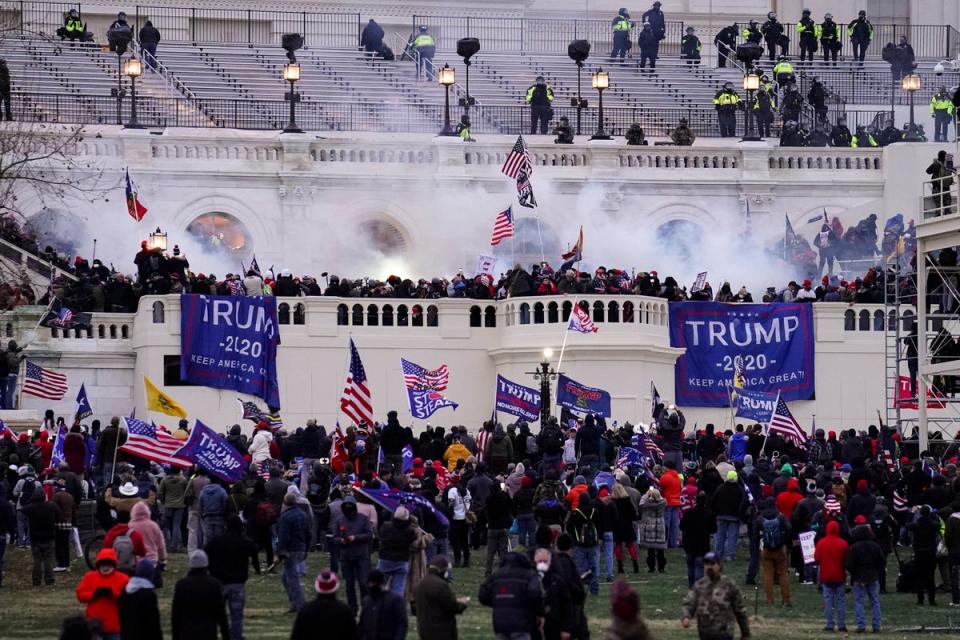Stewart Rhodes was a conspiracy theorist in search of a cause. He found one on January 6

It was a bright cold day in November, just a few days after Joe Biden had been declared the next president of the United States, and a few thousand people gathered in Washington DC to protest what they believed was a stolen election.
Donald Trump’s campaign to undermine the results of the vote he lost had only just begun, and the idea had not yet gained widespread popularity. These were the die-hards, the true believers: the Proud Boys, Boogaloos and the Oath Keepers.
The latter of those groups was hard to miss in the crowd that day. The Oath Keepers, one of the largest anti-government groups in the US today, claims in its ranks tens of thousands of former law enforcement officials and military veterans. I found them milling around in full military fatigues and green hats in view of the US Capitol building. Standing among them dressed all in black, and wearing his distinctive eye patch, was the group’s founder, 56-year-old Stewart Rhodes.
“It was stolen. There was massive fraud. They could not win clean, so they stole it,” he told me when I asked him to explain his concerns about the election. “It was like 10 million extra votes, and yet he still lost? We know it’s a bunch of crap. They stole the ballot in multiple ways.”
I had heard the same script of conspiracy theories from many Trump supporters in the aftermath of the election. Unlike Rhodes, however, most of those people didn’t have thousands of armed militia members under their command. And so I asked him what a stolen election meant for his armed organisation, whose members proclaim to be protectors of the constitution.
“What that means is that everything that comes out of his mouth will be considered just not of any force or effect. Anything he signs into law we won’t recognise as being legitimate, and it will be very much like the founding fathers, we’ll end up nullifying and resisting it,” he said.
And what does “resisting it” mean, I asked?
“Well when it comes time to enforce it we will defend ourselves against the enforcement,” he replied.
I went away that day wondering how serious Rhodes was about insurrection. Much had been written about the threat posed by armed groups like the Oath Keepers and the role they might play in post-election violence, but talking about overthrowing the government was one thing, doing it is quite another.
According to the FBI, Rhodes was deadly serious. At the very moment we spoke, he had already begun planning to violently interrupt the democratic process.
Rhodes was arrested on January 13, just over a year after the attack on the US Capitol, along with 10 other alleged co-conspirators. He was charged with seditious conspiracy for an alleged plot to “oppose the lawful transfer of presidential power by force,” according to prosecutors, which began just days after the 2020 election.
The arrest of Rhodes was seen as a key turning point in the investigation into the Capitol attack, for which more than 700 people have been arrested. The charges against Rhodes and his fellow Oath Keepers were the first targets of that investigation to face sedition charges, which carry a maximum sentence of 20 years in prison.
If proven, the charges against him would represent one of the most organised and serious efforts to overthrow the US government in modern history.

It was a long journey for Rhodes to the steps of the Capitol — one that tells us much about the trajectory of anti-government groups in the US after the past two decades.
Rhodes grew up in the Southwest in a poor family that moved around a lot, which meant he attended six different high schools. He joined the Army soon after graduating and became a paratrooper. He was in the service for only three years before he received an honourable discharge following an injury he sustained in a parachuting accident.
Tasha Adams, Rhodes’ ex-wife and father of his children, said there was nothing particularly out of the ordinary about his political views when they first met in 1991. She was just 18 at the time, he was 25 and working as a parking valet at a casino in Las Vegas. She worked as a dance instructor and the man who would years later try to overthrow the government came to learn ballroom dancing.
“He was conservative, but you know this was the Southwest, so everybody’s conservative,” she told The Independent by phone. “He did have a lot of conservative style talking points, but it was just normal. I think he was really typical for a young guy in that place, at that time.”
Adams and Rhodes were married in 1994, just three years after they first met. Adams said there were warning signs from the start, but Rhodes grew more radical after becoming involved in libertarian politics.
He enrolled at the University of Nevada and after graduating in 1998, took a job supervising interns for Congressman Ron Paul, a libertarian celebrity politician. He subsequently attended Yale Law School and graduated in 2004, before clerking for Supreme Court Justice Michael D Ryan.
She thought his descent into extremism wasn’t even necessarily politically driven. In 2008, when Paul ran for president, Rhodes volunteered for his campaign.
“I just kinda look at it like he’s a true sociopath and those people really liked to absorb energy from people. In 2008, the Ron Paul movement was huge. In Nevada, everywhere you went there were signs. People would shout ‘Ron Paul’ at stop lights. And I think he wanted to absorb that for himself,” she said.
The next year, shortly after Barack Obama was elected the first Black president of the United States, Rhodes announced the formation of the Oath Keepers at a rally in Lexington, Massachusetts. The group aimed to recruit former military, law enforcement and emergency first responders to uphold the oath they tookââ to “support and defend the Constitution against all enemies, foreign and domestic.”
According to the Southern Poverty Law Centre’s Hatewatch, a nonprofit which monitors and exposes the activities of the American radical right, the crux of the group’s messaging “asserts that the government is engaged in attacks against its own citizens, working to strip them of their civil liberties.”
It adds that the group “advocates for Americans to prepare for inevitable conflict with the government by stockpiling goods and supplies, engaging in paramilitary training and working to create small, self-reliant community networks.”
The group further adheres to the “New World Order” conspiracy theory, which affirms that “the government is secretly planning, along with foreign countries and the United Nations, to impose martial law, seize all Americans’ guns, force resisters into concentration camps and install a one-world totalitarian government known as the ‘New World Order,’” according to the SPLC.
Over the next few years the Oath Keepers would intervene in a number of disputes between groups and the government. They joined a protest in Quartzsite, Arizona, where local residents were ejected from a town council meeting. In 2014 they answered a call from Cliven Bundy to join a standoff against federal officials who were trying to seize his cattle for unpaid grazing fees.
By this time, Rhodes claimed the Oath Keepers had more than 30,000 members, Most independent research puts the number around 5,000.
At home, Rhodes had become increasingly abusive to Adams. She had been looking for a way out for years but feared what he would do to her.
“He was very abusive, and by then, once he had started the Oath Keepers, his friends are all police, his friends are all lawyers and he is very well respected. It was really obvious he was gonna use that,” she said.
She described a paranoid man who was intelligent and good at manipulating people. She shared images of "escape tunnels" and other protections in their backyard built by Rhodes "in case the feds ever came” to his door.

He would always have a small circle of close friends or comrades-in-arms, but that circle would change constantly, she said, as he made big promises and failed to keep them.
“He would do this future faking thing constantly — we’re gonna do this and that, and make all these promises, and then whoa, we can’t do it because of this reason. He always had an excuse.”
Adams saw Rhodes’ activity during these years as a way to get attention and power for himself, rather than a coherent or developing ideology.
“You have the Paul movement, and then a couple of years down the road you have the Tea Party movement, he kind of morphed and changed again and then came the Trump train. He’s just an opportunist,” she said.
Following Trump’s election, the Oath Keepers stance became significantly less anti-government and increasingly hostile to an imagined threat to the US by leftist groups and the Deep State. They appeared at Black Lives Matter protests armed, claiming they were there to protect property from looting. According to the SPLC the Oath Keepers “fully embraced Trump, and with help from Infowars host Alex Jones, increasingly promoted far-right conspiracies as the 2020 election approached.”
Dr Gina Ligon, director of the National Counterterrorism Innovation, Technology, and Education Centre (NCITE), which is currently working on a project studying the key influencers of the January 6 attack, told The Independent that the main feature of his ideology at the time of the 2020 election “was to protect Donald Trump’s power.”
“He had shifted from the anti-federal government beliefs in his earlier speeches to a conspiracy belief that anti-fascists and Black Lives Matter groups were actively trying to foment an overthrow of Trump’s Presidency.”
Some of those conspiracies were promoted by Trump himself, who claimed without evidence that Democrats were working to steal the election from him. Rhodes was taken in by all of it.
Just two days after the presidential election, before the results had confirmed Joe Biden’s victory, Rhodes began agitating. In an invitation-only, end-to-end encrypted group chat on communication app Signal, he told his followers to refuse to accept the election result.
“We aren’t getting through this without civil war. Too late for that. Prepare your mind, body, spirit,” he wrote.
A couple of days later, on 14 November, when I spoke with Rhodes in DC, he seemed calm but resolute. When I put it to him that there was no evidence to demonstrate there had been widespread fraud he didn’t get angry, but it was clear he wasn’t used to being challenged.
“That’s not true. You have definitive proof. When you say there’s no evidence, you don’t know what you’re talking about,” he told me.
“But these are circumstantial small scale things but no evidence of widespread voter fraud that could turn an election,” I replied.
“It’s all over the country. You gotta take your blinders off man. You’ve got a political bias,” he said, which I refuted, to no avail.
That protest, dubbed the Million MAGA March that was supposed to ‘Stop the Steal,’ was attended by a few thousand people. Alex Jones, the InfoWars conspiracy theorist, spoke to the crowd on the steps of the Supreme Court. At one point, Trump drove by and waved to protesters.
The actions and communications of Rhodes over the next few weeks are laid out in great detail in the indictment against him. They would show repeated calls for armed action to stop Biden from assuming the presidency, and rehearsals for confrontation with federal authorities.
On 9 November, Rhodes held an online video call in which he “outlined a plan to stop the lawful transfer of presidential power, including preparations for the use of force, and urged those listening to participate,” according to the indictment. The plan was set for January 6, the day the results of the presidential election would be certified.
On December 11, 2020, Rhodes sent a message to another Signal group which included several of his co-accused. He said that if Biden were to assume the presidency, “It will be a bloody and desperate fight. We are going to have a fight. That can’t be avoided.” A little over a week later he called for “a bloody revolution against them.”
In early January, Rhodes’ efforts moved from the theoretical to the real world. He began spending thousands of dollars on weapons: military-grade firearms and tactical gear. He spent $7,000 on two night vision devices and one weapon sight, the indictment said, and sent them to Washington DC, where they arrived on 4 January. He spent another $5,000 on “a shotgun, scope, magazines, sights, optics, a bipod, a mount, and gun-cleaning supplies,” according to the indictment.
In a group chat titled “Leadership Intel Chat” and other Signal groups, Rhodes and his fellow Oath Keepers planned for 6 January. “There is no standard political or legal way out of this,” he wrote to the group.
On the morning of the Capitol attack, Rhodes left a hotel in Virginia and drove to Washington DC. After an incendiary speech by Trump in front of the Washington Monument, crowds began to move towards the Capitol building. At a hotel in nearby Alexandria, Virginia, a “quick reaction force” of Oath Keepers was waiting with weapons to rush into Washington DC to intervene.
"The QRF teams guarded an arsenal of firearms and related equipment and were prepared to speed those weapons into the hands of co-conspirators on the ground in Washington when directed by Rhodes or other conspiracy leaders," court documents alleged.
The indictment alleges that Oath Keepers under Rhodes’ command marched towards it in a “stack” formation, before breaking into the building.
At around 2.12pm, Rhodes entered the restricted Capitol grounds on the northeast side, according to the indictment. While many of his team entered the Capitol building, there is no evidence that Rhodes himself did. But he continued to direct Oath Keepers from the outside.

At 3.30pm, according to the indictment, Rhodes messaged the Leadership Signal Chat: “Anyone in DC who is not tasked with a security detail, come to US Capitol on the Supreme Court side. Come to Capitol on the NE comer.”
Later that evening, at a restaurant in Vienna, Virginia, Rhodes and the co-conspirators “discussed the need to continue fighting to stop the lawful transfer of presidential power,” the indictment said.
The last message Rhodes sent on 6 January read: “Patriots entering their own Capitol to send a message to the traitors is NOTHING compared to what’s coming.”
Tasha Adams filed for divorce from her husband in 2018, but she has been watching his case unfold with interest. She has been vocal about his abusive past and spoken publicly about his path to extremism. In many ways, the Capitol attack was a culmination of everything Rhodes believed in. But in others, it was completely unlike him, which she said made her believe he was coordinating with someone in authority.
“I think they were trying to disrupt and create mayhem so that Trump could declare the Insurrection Act and they could buy time and say that the vote was flawed. It got much harder because Antifa never showed up,” she said.
“I think someone told him to do it. He is extremely risk-averse. He won’t do anything unless he thinks he can get away with it. And so that is the most suspicious thing that’s happened this whole time — the fact that he did something that could send him to prison,” she added.
Dr Ligon said that based on his affidavit, Rhodes “believed that Trump would enact the Insurrection Act and then activate the Oath Keepers as a legitimate militia. All of his planning was predicated on this belief. Perhaps when it didn’t happen, he had too many “sunk costs” and needed to act in a way that was consistent with his previous plans.”
“This was the most serious set of charges I have seen among anti-government group members, particularly given the digital footprint that the OK left. Having plans to ferry weapons across the Potomac to DC was historically symbolic but also required a great deal of careful planning,” she added.
Rhodes is currently being held at a federal prison facility in Oklahoma. Last month, a Texas judge ordered Rhodes be jailed pending trial in Washington, DC.
"The evidence shows Defendant orchestrated a large-scale attack on the federal government with the purpose of intimidating, by violence, federal officials and disrupting official governmental proceedings incident to the transfer of power in the Executive Branch following a national election," Magistrate Judge Kimberly Priest Johnson wrote in her opinion.
Judge Johnson added that Rhodes’ “authoritative role in the conspiracy, access to substantial weaponry, and ability to finance any future insurrection, combined with his continued advocacy for violence against the federal government, gives rise to a credible threat that Defendant’s release might endanger others by fostering the planning and execution of additional violent events."
The judge also revealed that Adams contacted the court after Monday’s detention hearing and she reportedly testified to Rhodes’ “violent tendencies,” and that she feared for her safety and the safety of her six children should he be released.
So how serious was Stewart Rhodes about overthrowing the government? And what of the people he took along with him? Did these weekend warriors really believe they could overturn the electoral process? Did they really believe they could fight a war against the government? According to Adams, it’s a mixed bag.
“I think there are some in that group that thought they were gonna go to war. They didn’t seem very intelligent. And they’re exactly the kind of people that Stewart would have around him,” she said.


